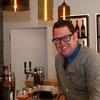
The rooftop observation deck of the MAS museum in Antwerp provides an opportunity for some fantastic panoramic views.
Belgium is one of the top destinations for beer fans around the world. With a host of world famous breweries and bars, Belgium can fulfill your beery travel dreams. The beauty of traveling through Belgium is its small geographic size and good public transportation system. While Belgium isn’t the most difficult country to travel in, it does have its own idiosyncrasies that warrant examination. Hopefully this guide will set you on the path to a thoroughly enjoyable visit to one of my favorite destinations: Belgium.
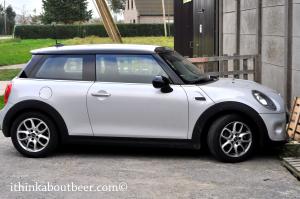
My fun rental: The Mini Cooper
Transportation
- While the Brussels airport isn’t the best, it’s often cheaper to fly into Belgium directly than to go to one of the other major cities in nearby countries and taking alternative routes. When I was looking, it cost quite a bit more to stop in Amsterdam and take a train than for the same flight continuing on to Brussels.
- If you have good travel flexibility, you’ll want to examine the European Parliament’s meeting schedule. If Parliament is in session, flight prices will be higher. Fortunately, their schedule is posted online well in advance. Also, the parliament also meets in Strasbourg sometimes. When it’s in session in Brussels, the city will be much busier. EU Calendar is available here.
-
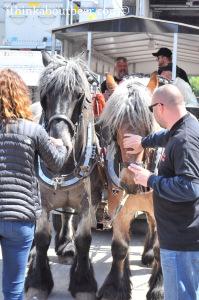
Be nice to the locals, they might give you a ride to some beer! (Van Steenbeerge’s horses)
The train system in Belgium will get you to most places you want to go. It’s pretty easy to get anywhere you want in the more densely populated Flemish North. The national rail website is also good at providing you information on your transportation options after you get off the national lines and into the city or rural systems. It’ll show you the combination of city trams and buses to get you to your final destination.
- If you’re going to be making a lot of train trips, they offer a nice 10 ride ticket. You just fill in your destination on the slip as you get on the train and the conductor will validate it.
- Your foreign credit card won’t work in the automatic ticket booths. You’ll need to use change or go to a manned booth.
- If you’re desperate on time, just get on the train and when you see a conductor approach them and let them know you need a ticket. They can sell you one right there. This is also handy if you’re catching a late train and the booths are closed.
-
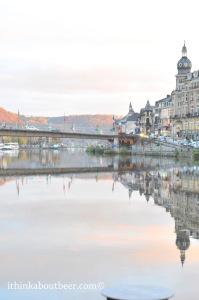
Dinant – River and Cathedral
If you’re going to Wallonia, you’re most likely going to have a lot more trouble getting around, especially if you’re visiting some of the more far flung of the Walloon breweries. You’ll almost always be better off renting a car.
- I spent 2 weeks driving around Belgium, mostly in the Walloon south and West Flanders. I really had a great time doing it. My first rental was a Mini Cooper. I highly recommend getting one of these if you have the chance. It’s a fun car to drive. I wish I’d had it for more than the first 2 days. The next vehicle was a serviceable Mercedes-Benz wagon (keep in mind, M-B makes a much wider range of cars than the luxury models we see on US streets). The fuel economy was great but, it wasn’t exactly a fun machine like the Mini. I drove for an entire week on the full tank I started with.
- Driving in another country is always an experience. It’s up to you whether you find the experience fun or not.
- Antwerp, Ghent, & Brussels are renowned for their terrible traffic; not just anecdotally, but in actual traffic studies. Driving is not your best option in these cities, but you may have to navigate these places once you get off the train and pick up your rental car. Brussels in particular can be a crazy series of wrong turns and missed signs.
- Belgium is not a place for “polite” drivers. You’ll have to force your way into traffic. This is especially true when you’re crossing traffic to make a left turn. You’ll have to shove your nose in so they make room. Otherwise they’ll just pile up in the intersection so they don’t get caught behind the light.
- Speaking of street signs, they’re almost impossible to see when you’re driving. Unlike in American cities where the signs are neatly placed on posts at the corners, in Belgium, the signs are affixed to the nearest building. This can make them difficult and dangerously distracting to find.
- In the Flemish portion, the street will end with “Straat” (street). Often, there won’t be a space either. So for instance, Paleis Straat might appear on a sign as Paleisstraat. In Wallonia, “Rue” is the most common word for street printed on signs. Except it often precedes the street name: Rue de Namur for instance.
- GPS IS A MUST!!! I can’t say it enough. Don’t think you can wing it and get to your destination on time, or probably at all. And don’t rely on your mobile phone for GPS. The cell coverage in Belgium is surprisingly spotty when you leave a town or city. It’s especially weak in Wallonia. If you’re going to be driving, the single best investment you can make is upgrading to a GPS in car. Seriously, I can’t say it enough.
- The highway speed limit is usually 120kph (about 75mph). However, traffic tends to flow at around 130-140kph. If you’re uncomfortable whipping through the country side at these speeds, stay to the right and let the crazy Euro drivers whiz on by.
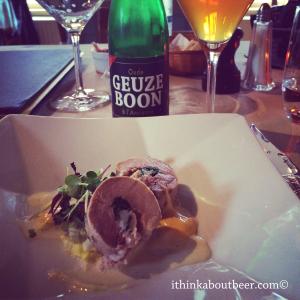
Lunch and beer pairing at ‘t Hommelhof in Watou, West Flanders
Drinking
- Water is your friend. Unlike in the US, you don’t have a constant glass full of free tap water. You’ll have to buy bottled water. While this will add a bit more to the tab, it’ll be a worthwhile investment.
- Order sparkling water. It’s often listed on the menu as petuillante. The bubbles will seriously liven up your palate, especially after a day of drinking the big beers of Belgium. Not only will you get much needed hydration, but you’ll freshen up your mouth for the next round of tastiness.
- I wouldn’t even bother trying to order tap water. Your server will look at you like you’re from Mars or you’ve got a second head. In the 6+ total weeks I’ve spent in Belgium over the last couple of years, I think I managed to get tap water once.
- While American craft drinkers are often overly excited about draft beer, bottles are often your better bet in Belgium. A lot of breweries pasteurize and filter the draft versions of their beers. There are a few exceptions, and knowing them will lead to drinking rewards.
- Draft Lambics are often a good choice, especially if you see a cask version. This is a newer trend for serving Lambics.
- Hazier beers often indicate a keg conditioned beer.
- Often, bars are tied houses meaning they have to carry a certain number of beers from one brewery by contract. Frequently, you’ll see a draft lineup clogged with just one brewery’s beers, like: Jupiler, Leffe, Hoegaarden if you’re in an Ab-InBev house. People will place their specialty beers on the bottle menu, which is another reason bottles tend to be a better choice.
- Be careful when ordering Gueuze. If you don’t see the word “Oude” on the menu or bottle, you might have one of the sweetened/forced carbonated mass market versions. Not all Lambic houses make these, but a few of the bigger more mainstream ones do. Cantillon is an exception to this rule. They’re not a member of HORAL, the Gueuze/Lambic trade group, so are not allowed to use the “Oude” term. All of their beers are traditional and authentic.
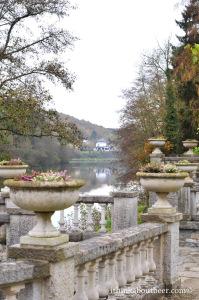
Castel les Sorbiers outside of Dinant
Service
- Bar and Restaurant service is often quite different than in the US. Servers get paid a good wage so they’re not looking to hustle for your tips. This also means they’re not trying to get you in and out and turn the table for a new customer. So while some may view this as poor service, I prefer to think of it as a much more relaxing situation. You can sit and enjoy your time without feeling like your being chivied out the door.
- You’ll probably need to flag down your server or order at the bar when you’re ready for another round. This goes back to what I said earlier about the service style.
- You don’t have to tip your server. People just usually leave the small change at the table when they’re done. This isn’t an insult, just custom since they’re paid properly.
- Watch out for 1€ or 2€ coins, they don’t use paper for anything under 5€. You could leave way too much change at the table if you’re not paying attention!
Restrooms
- The first time I walked into a restroom at a bar, it took me a couple seconds to figure out what was happening. There was only one door in; urinals against one wall and stalls with doors against another wall. Some of the doors had the “female” logo on them. Restrooms are often shared by the sexes with less than the normal amount of privacy Americans are used to in this situation. As a man, you can be using the urinal while a woman walks in and heads to a stall. It’s a little odd at first, but you get used to it.
- Public restrooms are not free. Usually, they’re .50€ to enter. Either they’ll have an attendant at the entrance collecting the change or an automated door that will let you in after you drop your money into the slot. The flip side of this is that the attendant keeps the bathroom well stocked and very clean. I would highly recommend keeping several .50€ in your pocket.
- This includes gas stations. You don’t see roadside rest areas like you do along US highways. You’ll have to stop at a service station to use the restroom. Almost all of them are pay to enter.
- Public restrooms are not free. Usually, they’re .50€ to enter. Either they’ll have an attendant at the entrance collecting the change or an automated door that will let you in after you drop your money into the slot. The flip side of this is that the attendant keeps the bathroom well stocked and very clean. I would highly recommend keeping several .50€ in your pocket.
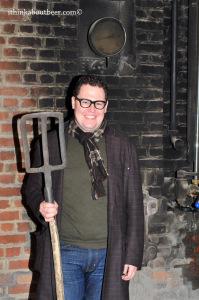
Looking sharp and holding a brewer’s fork at Br. Caracole
Attire
- Europeans as a whole are a well-dressed lot. You rarely see people in shorts, sandals, or t-shirts (although they’re becoming more popular with younger generations). A good pair of jeans, a button down, a sweater or cardigan, a smart-looking jacket or coat, and a scarf will help you blend with the locals (weather permitting). Fortunately for your walking comfort, wearing athletic shoes has come into fashion in Europe. But even here, you’ll want to stick with dark and simple designs. Neon colors and wild patterns are seldom seen.
- Invest in a good pair of shoes before you go. You’ll be doing a lot of walking on cobblestone roads and other uneven walking surfaces. A good pair of shoes will save you a lot of trouble. Chances are, you might use up the majority of the shoe’s life on the trip so don’t try to wear an old pair. A pair of broken down shoes will come back to haunt you.
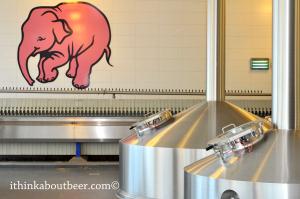
Brouwerij Huyghe – Pink Elephants and Steel Tanks
Belgium: Beer Paradise
- Belgium has often been marketed as and thought of as a world beer paradise. And it truly is. However, be prepared. Not ever bar you walk into will have an amazing selection of beers from all over the country. They may have one or two local, traditional offerings; but the lineup will probably be dominated by the bigger lagers and their quasi-specialty brands. AB-InBev is the biggest by far. Like the US, there a lot of bars that are what we’d call “clear beer bars.” While some of these places have their own charm, don’t expect to find some wacky and obscure beer you’re looking for on the menu.
- When I was traveling through the deep south of Belgium, you could find Orval in every bar. But could you find local beers like La Rulles or Troufflette? No. Lineups are not all about having every local beer. They’re about fulfilling contractual obligations and having some of the long standing traditional, regional beers that people expect. You’ll be hard pressed to find a Saison Dupont in Antwerp. You’ll be even harder pressed to find a Hof ten Dormaal in Namur.
- Fortunately, this is changing slowly as the Craft Beer Movement takes hold in Belgium. More bars are adding more bottles to their lineup and trying to increase their diversity of options. Obviously there are the big name beer bars to visit: Moudre Lambic, Delirium Café, De Kulminator. But don’t be afraid to stop into a neighborhood pub while you’re out in the far wilds of the Ardennes. Even if it looks like a real dive, you can find your choice of a “jeune” or properly cellared “vieille” Orval. Turns out that dive is an Orval Ambassador bar. Experience the locals and where they hang out. Explore the whole beer scene of Belgium and carve your niche. You’ll be rewarded handsomely.
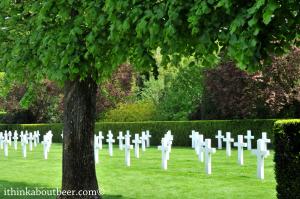
Stop by some non-beer related sites: The WWI American Cemetery outside Ypres
- Call ahead! Most breweries in Belgium don’t have standing tours. This is starting to change with some breweries, particularly the few breweries in the bigger cities. Some breweries only offer tours to larger groups. There’s usually a fee associated with tours. If you reach out directly to breweries that you want to visit, they may be kind enough to set up an appointment for you to visit.
- There are very few breweries left in the major cities of Belgium. Most breweries are in smaller towns and village strewn about the countryside. Here are two noted exceptions:
- Cantillon (Brussels) is always open for self-guided tours.
- De Halve Maan (Bruges) has a couple of scheduled tours a day.
- If you don’t want to put in all the work of setting up your own appointments; and you’re looking for a very beer heavy trip, you may want to look into one of the beer tour specialists out there. Stu Stuart of Belgium Beer Me! Beer Tours of Belgium runs a good operation. He has great contacts at breweries you probably would never be able to visit on your own. He has many tours available depending on your time window or the theme you’re looking for. (This is not a paid mention).
- Another great tour option, if you’re feeling up to working for your beer, is a bicycle tour with my friend Evan Cohan of Beercycling
- There are very few breweries left in the major cities of Belgium. Most breweries are in smaller towns and village strewn about the countryside. Here are two noted exceptions:
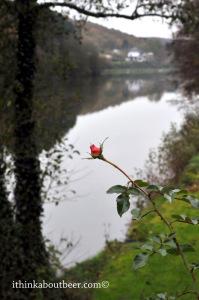
Don’t forget to stop and smell the roses…
What are your tips for Beer Travel in Belgium? What else would you like to know? Share your travel experiences in Flanders and Wallonia!
And stay tuned for some tips for the more advanced beer traveler!


